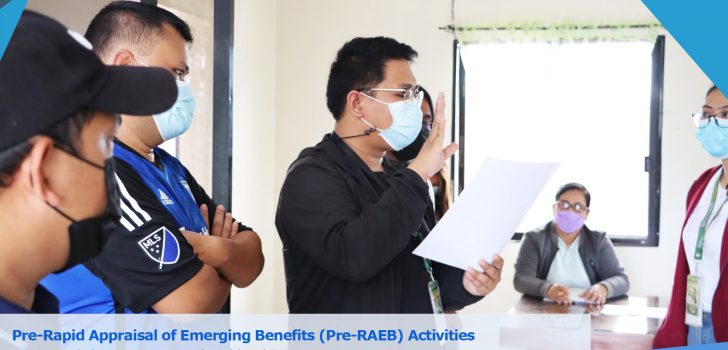
Pre-RAEB activities for completed Cadiz FMR held
In view of arming the group with the basic information and processes in the actual conduct of the Rapid Appraisal of Emerging Benefits (RAEB), the Regional Project Coordination Office 6 and Project Support Office Visayas held Pre-RAEB activities in collaboration with the Provincial Project Management and Implementing Unit (PPMIU) Negros Occidental for the Rehabilitation of the 12.46-kilometer Barangay Caduhaan – Sitio Aluyan Farm-to-Market Road (FMR) in Cadiz City, Negros Occidental on February 21-24, 2022.
The four-day Pre-RAEB activities which include consultations, respondents identification/sampling, initial farm profiling, geotagging and validation of household survey respondents, initial processing of respondents’ profile, and validation of secondary data was led by the Monitoring and Evaluation (M&E) Unit. Other DA-PRDP components and units involved in the conduct of the activity were the I-BUILD Component and I-SUPPORT Component such as Geomapping and Governance Unit (GGU), Social and Environmental Safeguards (SES), Economics Team, InfoACE Unit and the designated PPMIU officials of the Province.
According to PSO Visayas M&E Officer Archie Rose P. Quanico, these activities are vital to get the initial information in the conduct of the RAEB proper which is targeted to be held in the month of April this year.
“As we acquire initial information through this pre-RAEB, we would be able to generate a report that will serve as our database and guide us on how should we go about our actual conduct of RAEB scheduled to be held this April,” said Quanico.
Quanico further explained the processes and tools utilized in the conduct of activities involving the RAEB.
The methodologies used were Applied Geotagging Technology wherein the target household survey respondents’ residence and farm was photographed using the AGT to ensure and validate the inclusiveness in the Road Influence Area (RIA); Focus Group Discussion (FGD) on substantiating the findings that emerged from the Household Survey; Key Informant Interview (KII) on the prevailing plans, Operations and Maintenance strategy and budgeting as well as policy issuances, which are crucial for the sustainability of the subproject, Household Survey in obtaining feedback from the households accessing the FMR subproject giving special focus on the stream of benefits such as travel time, reduction in hauling cost per trip, reduction in transport losses, and Spot Interview with the project beneficiaries to capture thoughts and experiences in the barangay who were not part of the Household Survey and FGD.
Among the responses during the spot interview conducted was from Godofredo Arca, resident of Barangay Aluyan and one of the project beneficiaries. He distinctly compared the situation before and after the road was constructed.
“Before, this road is very difficult for us to traverse and we need to walk at least 3-4 kilometers before finally reaching the town proper. Everytime the rain would pour, it is very difficult for us to cross the bridge because of flood. It is also hard for us to buy our needs in the market and we often go home by nighttime since our place is too far from the town proper. Fortunately, it is now easy for us to travel anytime since most of us here already owns a vehicle thus, it has also lessened our travel time from 2 hours to 25-30 minutes,” said Arca.
He also highlighted the changes that have transpired in terms of their tourism and agricultural industries with the easier road access.
“This road also opened the tourism in our area wherein there were numerous coffee shops that have opened here that people often visit. Also, the marketing of our farm products like banana is no longer difficult since the buyers themselves are going here to buy our produce,” he added.
A 98-year-old local of the barangay, Rosita Jumayon, described the difficulty they have experienced long before while transporting their products to the market.
“Before, we only load our products like copra through a carozza, a carriage pulled by a carabao, until we reach the railway then transfer them on a baganita or railroad carriage pulled by the horse. After we reach nearly the town where motorcycles are available, we transfer our products to finally reach the market. We are truly glad that today we already have a concreted road. It is no longer difficult for us to transport our products since there are already many vehicles that pass by and we no longer have to transfer our products from one vehicle to another,” expressed Jumayon.
The RAEB for FMRs is being undertaken for completed or substantially completed subprojects with the entire stretch of the road used by farmer/fisherfolk beneficiaries for at least one cropping season for the priority commodity to validate immediate initial outcomes of the subproject. Its framework uses several methodologies to gather information to validate the stream of benefits of the subproject. (April Grace Padilla, RPCO 6, Writer)



